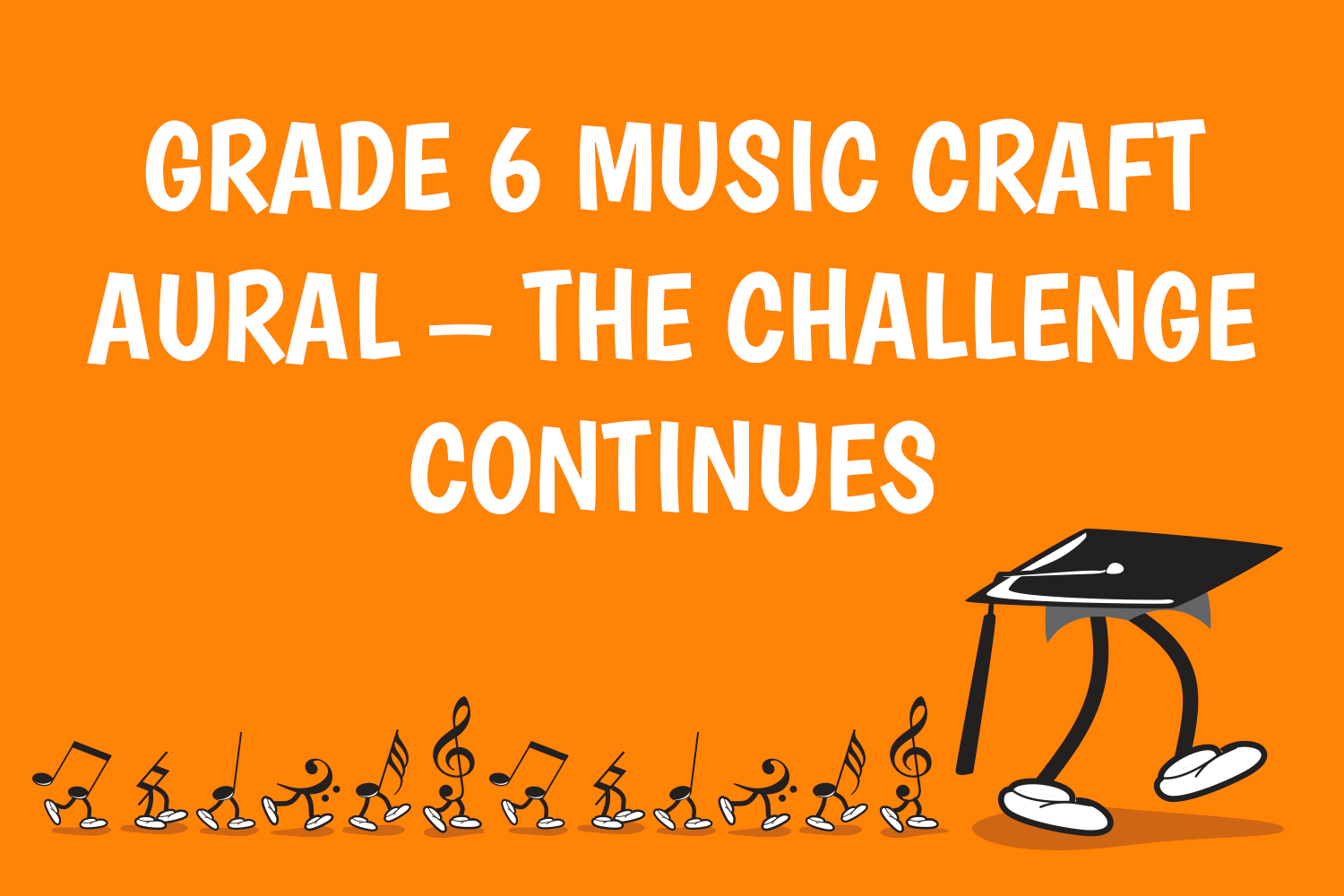Grade 6 Music Craft Aural – The Challenge Continues

As I was sitting in my living room doing the laborious and tedious job of stapling BlitzBooks flyers together for an upcoming promotion, I thought it would be a good use of my time to listen to and attempt the Grade 6 Music Craft Aural exam.
Armed for multi-tasking with the test paper, a pencil and rubber on my right, and a stapler plus 1300 flyers on my left, I pressed ‘play’ on the CD.
The good news is that I did not find Grade 6 all that much harder than Grade 5. That is, I got quite a bit of stapling done, and there were no times where I had to stop the CD due to fits of tears or laughter. For those of you who have read my blog on Grade 5 Music Craft aural, you’ll know that I felt it was way beyond my students’ capabilities (and in terms of the rhythm dictation, also beyond my own and all of my colleagues’!). So although Grade 6 seemed to be a manageable step up in difficulty from Grade 5, it still challenged my aural skills (which I enjoyed) and in my opinion remains out of reach of most students attempting this level. Or, to put this in their words: ‘ARRRGGHH! IT’S TOO HARD!’
So, rather than outlining the obvious difficulty of the aural tasks themselves, the purpose of this account is more to describe the differences in presentation between the test paper and the ‘Essential Exercises’ book and CD that the AMEB has published as a preparation tool. This is something teachers and students will need to be well aware of if they are to succeed in the exam.
Question 1a: Chord recognition
With a repertoire of 14 (yes, 14) different chords to recognise (including inversions), this will take a lot of practice. What’s really hard is trying to recognise the position of the chord when it’s heard as an open chord. I have many students who struggle with identifying an inversion of a chord in closed position, let alone open! There are a fair few instances of this on the workbook CD, but this is a very advanced skill and teachers will need to drill it extensively.
Question 1b: Chord Progressions
This is presented very differently to the workbook, in which the first chord number is given, and the student has to write down the chord progression as it is heard on the CD. In the test paper, the first chord is not named for the student but rather is notated in manuscript. The test paper says ‘The key and first chord appears below’ but in fact the key signature in itself does not tell us the key. So we have to analyse the chord and key signature, decide on the two possibilities (e.g. chord I in a major key is the same as chord III in the relative minor) and then adjust as soon as the progression is played, trying to determine whether it is major or minor. For students who practice this skill solely in the format of the workbook, it will be a bit of a shock having to do it in such a different way in the exam.
Question 1c: Modulation
This is pretty easy! In fact it is on par with the modulation question in the Grade 6 Musicianship syllabus. In the workbook we are always told the opening key, and all of the examples are homophonic in texture. But… in the test paper, a key signature is printed and we are not told whether it is major or minor (and so have to work it out from listening). And on top of all of that, the exam question was in a contrapuntal style, which is not what I expected at all and made it quite tricky!
Question 1d: Melodic Dictation
I was pretty sure, in fact quite hopeful, that there was a misprint on the paper, because there was no clef, key signature, time signature or first note on the page! I guessed D major from the tonic chord given (one of the few times I’ve wished I had perfect pitch – more about that in another blog), and from the pulse I could tell that it was in 6/8.
Now, about the pulse. It is very, very, VERY helpful to be given the pulse. It would be even more helpful to be told the number of bars, which we are not, but a pulse is helpful nevertheless. In the workbook, no pulse is given (and this is the same with Grades 2-4) which makes it extremely difficult, especially since quite a lot of the opening notes are just black note heads with no stem (which means it could be a crotchet, dotted crotchet, quaver, dotted quaver or a semiquaver, according to the syllabus). So at least here is an example of the test conditions being slightly EASIER than the workbook conditions, and teachers can relax if this it to be the case from now on. (Which it may not be. So actually we probably shouldn’t relax.)
A word about the actual melodic dictation: it took me all five playings and I’m only pretty sure I got it. Pretty sure isn’t really good enough, for me anyway.
Question 1e: Lower Part Dictation
I found the lower part dictation itself to be quite achievable, but it’s impossible to know whether that’s simply due to the fact that I could easily distinguish which was the lower part.
In my experience, many students struggle with singing back the lower part in the aural tests in their practical exams. Our ears naturally tune in to the higher frequencies and hearing the lower part is really much more difficult than hearing the upper part. Actually writing down what we hear is an even more finely tuned skill, one that needs to be practised a great deal.
In the Grade 6 workbook, all of the instances in which this skill is tested feature the two parts played on two different instruments, making it much easier to distinguish between the two parts because of the different timbres. However, in the test paper, both parts were played on piano, which is something I was not prepared for and will definitely be more troublesome for students.
Question 2: Rhythm
This was a total breeze – more manageable than any dictation I’d heard in Music Craft Grade 4 or 5! It was 8 bars long in mixed metre, but the bars were mapped out with the time signature changes. I got it in 2-3 playings (and used all the extra time to get more stapling done). This is very different to trying to decipher a rhythm dictation that goes on and on, without knowing how long it is supposed to be, a la the Grade 5 test.
But even as I rejoiced at this very manageable level of difficulty for Grade 6, I can see there may be a danger of being lulled into a false sense of security. The exercises in the workbook incorporate two styles of rhythm dictation: one in mixed metre (in which the bars and time signature changes are always mapped out) and one in a single time signature but of an undetermined length (again, a la Grade 5). The workbook examples in mixed metre are extremely difficult, but nevertheless will prepare a student well for this exam. I found the ‘single metre’ examples in the workbook impossible to get within five playings, which is the amount given in the exam.
Question 3: Set Works
There is no question 3 on the CD, due to copyright restrictions. It is not possible to find out how this question is presented in the exam without entering for the actual exam, and there are no examples of this kind of testing in the workbook, even in the ‘Sample Aural Paper’ at the end of the book.
Whilst this is somewhat frustrating, it has been the case for some time in regards to the Musicianship syllabus, so this really is nothing new. As teachers we can only prepare our students as adequately as we know how, and hope that the testing will be fair and appropriate.
This brings me to my concluding point: as teachers (in fact as human beings) we tend to accept things as they are when they have been like that for a long time, even if those things are inconvenient, such as not being able to find out how a Set Works question will be presented in the Musicianship syllabus. It’s easy to let ourselves get all huffy when something new comes along that takes us out of our comfort zones, like the (relatively) new Music Craft syllabus. My esteemed colleague and mentor Rita Crews told me that when the ‘brand new’ Musicianship syllabus was first released some 40 years ago, there was practically rioting in the streets!
There is no question that some things need ironing out. But this can only happen if teachers give feedback about these issues. I encourage all teachers to contact the Federal AMEB office with feedback about Music Craft or any other syllabus issue you feel needs addressing. (Note: enquiries or feedback involving scheduling or marking should always be directed to your State office.)
Click on this link to go to the ‘Contact Us’ page on the Federal AMEB website, which has links to all the State offices.

Thank you very much for the BlitzBooks series. Will there be a “How to Blitz! Grade 6 Theory” released soon?
There are no plans for Grade 6 – sorry about that!